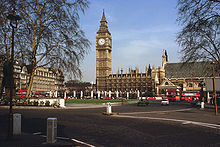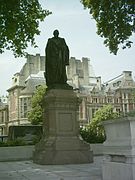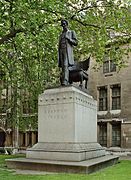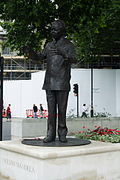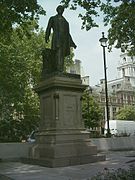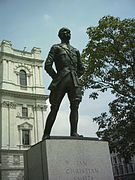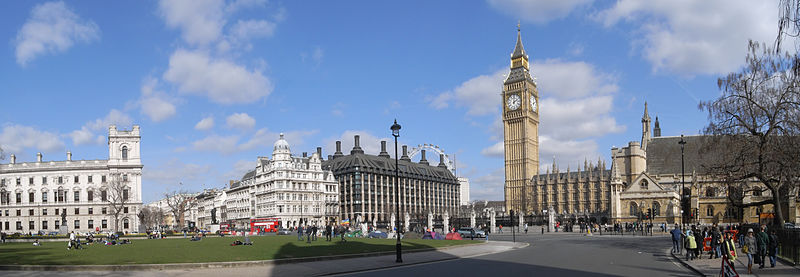- Parliament Square
-
For other uses, see Parliament Square (disambiguation).
 Anti-war protesters gather at Parliament Square on the afternoon of 20 March 2003, as seen from the roof of the Palace of Westminster, with New Palace Yard in the foreground.
Anti-war protesters gather at Parliament Square on the afternoon of 20 March 2003, as seen from the roof of the Palace of Westminster, with New Palace Yard in the foreground.
Parliament Square is a square outside the northwest end of the Palace of Westminster in London. It features a large open green area in the middle, with a group of trees to its west. It contains statues of famous statesmen and is the scene of rallies and protests, as well as being a tourist destination. It symbolically represents different arms of the state on each side of the square - Legislature to the east (the Houses of Parliament), Executive to the north (Whitehall), Judiciary to the west (the Supreme Court), and Church to the south (Westminster Abbey).
Contents
Location
Buildings looking upon the square include Westminster Abbey and St Margaret's, Westminster, the Middlesex Guildhall (the seat of the Supreme Court of the United Kingdom), Government Offices Great George Street serving HM Treasury and HM Revenue and Customs, and Portcullis House (and so Westminster tube station).
Roads coming off the square are St Margaret Street (becoming Abingdon Street and then Millbank), Broad Sanctuary (becoming Victoria Street), Great George Street (which becomes Birdcage Walk), Parliament Street (becoming Whitehall), and Bridge Street (becoming Westminster Bridge).
Statues in and around the square are mostly of well-known statesmen, and include ones of Winston Churchill (on the north-Eastern edge of the green and facing east, overlooking Parliament), Abraham Lincoln (in front of Middlesex Guildhall), Robert Peel (south-western edge of the green), Lord Palmerston (north-western edge of the green), Jan Christian Smuts (northern edge of the green), Derby, Disraeli, and George Canning. On 29 August 2007, a 9-foot-high (2.7 m) bronze statue of Nelson Mandela was erected in the square, Westminster City Council having objected to its erection in Trafalgar Square, due to space considerations. It was unveiled by the British Prime Minister, Gordon Brown, in the presence of Wendy Woods, the widow of Donald Woods, the late anti-apartheid campaigner, and the British actor, director and long-time friend of Woods, Lord Attenborough.
History
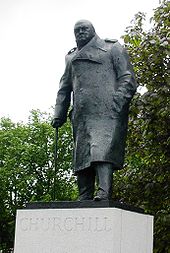 The statue of Sir Winston Churchill in Parliament Square.
The statue of Sir Winston Churchill in Parliament Square.
Parliament Square was laid out in 1868 in order to open up the space around the Palace of Westminster and improve traffic flow, and featured London's first traffic signals. A substantial amount of property had to be cleared from the site. The architect responsible was Sir Charles Barry. Its original features included the Buxton Memorial Fountain, which was removed in 1940 and placed in its present position in nearby Victoria Tower Gardens in 1957. In 1950 the square was redesigned by George Grey Wornum. The central garden of the square was transferred from the Parliamentary Estate to the control of the Greater London Authority by the Greater London Authority Act 1999. It has responsibility to light, cleanse, water, pave, and repair the garden, and has powers to make bylaws for the garden.
The east side of the square, lying opposite one of the key entrances to the Palace of Westminster, has historically been a common site of protest against government action or inaction. On May Day 2000 the square was transformed into a giant allotment by a Reclaim the Streets guerrilla gardening action. Most recently, Brian Haw staged a continual protest there for several years, campaigning against British and American action in Iraq. Starting on 2 June 2001, Haw left his post only once, on 10 May 2004 - and then because he had been arrested on the charge of failing to leave the area during a security alert, and returned the following day when he was released. The disruption that Haw's protest is alleged to have caused led Parliament to insert a clause into the Serious Organised Crime and Police Act 2005 making it illegal to have protests in Parliament Square (or, indeed, in a large area reaching roughly half a mile in all directions) without first seeking the permission of the Metropolitan Police Commissioner. The provisions of the Serious Organised Crime and Police Act relating to Parliament Square were repealed by the Police Reform and Social Responsibility Act 2011, which provides for a different regime of "prohibited activities".
As well as sparking a great deal of protest from various groups on the grounds of infringement of civil liberties including the European Convention on Human Rights, the Act was initially unsuccessful in accomplishing its goals: Brian Haw was held to be exempt from needing authorisation in a High Court ruling, as his protest had started before the Act came into effect (though any new protests would be covered); Haw remained in Parliament Square. Later, the Court of Appeal overturned this ruling, forcing Haw to apply for police authorisation to continue his protest.
Democracy Village
In May 2010, a peace camp known as Democracy Village was set up in the Square to protest (initally) against the UK government's involvement in invasions on the Middle East, which became an electic movement encompassing left-wing causes and anti-globalisation protests. The Mayor of London, Boris Johnson applied to the courts to have them removed and, after they lost an appeal in July 2010, Lord Neuberger ruled that the peace protesters should be evicted.[1] Tents have since returned at the end of 2010, this time on the paving and not on the actual grass itself which is protected by fencing.
Gallery
Additional statues
Henry John Temple, 3rd Viscount PalmerstonPanoramas
References
- ^ http://www.bbc.co.uk/news/uk-england-london-10659518 Parliament Square protesters lose eviction appeal], BBC News, 16 July 2010.
Further reading
- Simon Bradley and Nikolaus Pevsner, The Buildings of England, London 6: Westminster (2003). ISBN 0-300-09595-3.
External links
Categories:- Squares in Westminster
- 1868 establishments
- Road junctions in London
- Parliament of the United Kingdom
- National squares
Wikimedia Foundation. 2010.

